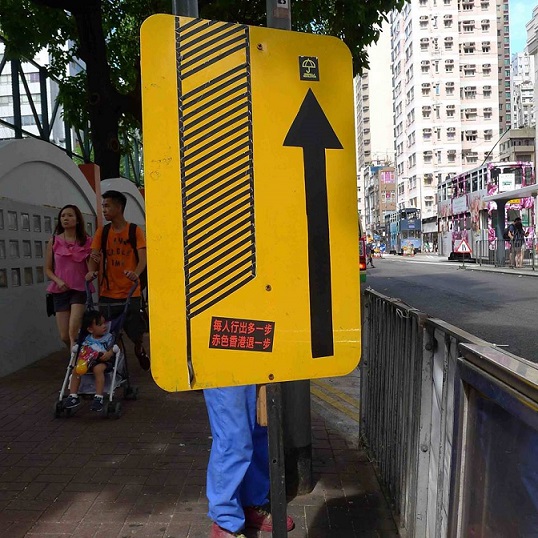藝評
拍攝愚昧 Photographing Stupidity
約翰百德 (John BATTEN)
at 11:41am on 19th August 2015

Photo: John Batten
(Please scroll down for English version.)
香港是一個「大」新聞很快不再是大新聞的地方。城市的急速節奏,迫得任何具有新聞價值的事物,都要經歷速時事性評估。而那些以記者為主,負責撰寫新聞的人員,也會以高速地尋找新故事,確保「舊聞」 不會被認為過氣。今時今日的社交媒體,強調所有事件在本質上都只值片刻,事情的歷史很快便會被抹走,由其他事物補上,然後逐一被取代。執筆之時,城中的最新醜聞是公共屋邨食水含鉛。當你讀到這篇文章時,不妨留意這宗事態嚴動的水新聞是否仍然備受它應得的關注,還是重要性已退守二線,甚至已經消失。
2015年6月18日,我拍下了這張看去毫不重要的路標照片,路標放在灣仔莊士敦道電車站附近,而且放在那裡最少已有兩年時間。我也不是唯一一個把它拍下的人。著名藝術家及設計師黃炳培便告訴過我,他也拍過這個路標的照片。
這個路標對於攝影師來說,到底有什麼吸引力?法國理論學家羅蘭•巴特(Roland Barthes)的攝影著作《明室》(Camera Lucida,1980年出版),是經常被引用的書籍,當中便透露了一些端倪。巴特在書中提出了一套理論,說明每天數以十萬計的照片中,如何判別與眾不同作品的方法。
巴特指出,一幀好照片必須能夠建立文化和政治環境,這樣才可以讓自己被詮釋。巴特把這個說法稱為照片的「知面」。而為照片賦予更多深度則稱作「刺點」。「刺點」就是照片的特色,一個突出之處或一個細節地方,可以為照片創造個性,並與觀者直接地或個人化地締造關係。
我鏡頭下的路標,原意是警告駕駛者修頓球場電車站附近正興建小巴停車處。路標最初設置時我便留意到了,因為用來表示建築地帶的影線有一條線不見了,看上去十分奇怪。這種建築路牌以乙烯基條子手製,在香港隨處可見,一向都十分有效。線條不見了是一個很小的錯誤,但卻為照片提供了一個刺點層次。
路標的樣子在6月18日卻更顯趣味。這天,立法會就政府提出的政改方案進行投票。在這段時間左右,路標上貼上了宣傳爭取普選的貼紙,這些貼紙令路標(和我的照片)加上了一重公然的文化與政治維度,為照片建立了知面。照片的刺點還有其他層次,包括路標下只見藍褲不見面目的路人,為畫面添上一點神秘色彩。右方的電車和一對推著嬰兒車的路過夫婦則為照片加上了家居的元素。
這個場面是稍縱即逝的,但所有為6月18日加上文化和政治新聞價值的元素,都一一被這幀照片保留了下來。
6月18日發生了什麼事,大家都很清楚:建制派議員因為組織混亂(又或如親政府議員田北俊毫不避忌地以「愚蠢」來形容),在會議上離席,因而錯失最後的投票機會,令方案的正式投票紀錄變成了大比數反對政府的政改方案。很多新聞都圍繞最單純的愚昩,最近便有鉛水事件、港公司跨境高鐵項目嚴重超支、官僚人員以未持有小販牌照的罪名檢控在行人路上修理單車的老翁等。
莊士敦道那個路標仍然豎立在那裡:在實際作用上,它現在用來警告沿路100米外有更多建築工程正在進行。這個路標將永遠和透過這張照片所捕捉的歷史,提醒我什麼是制度的愚昧。
原文刊於《明報周刊》, 2015年8月1日。
Photographing Stupidity
‘Big’ news isn’t big for very long in Hong Kong. The fast pace of the city forces anything newsworthy to be quickly assessed for its topicality. And, those that write-up the news – mainly journalists –quickly seek new stories to ensure the ‘old’ news is never perceived to be stale. Nowadays, social media emphasizes the momentary nature of all events, whose histories are quickly swiped away, replaced by other, soon to be replaced events. As I write, the latest scandal is lead contaminated water in public housing estates. By the time you read this, consider whether the water story is still receiving the attention it deserves, or has become a lesser headline or disappeared, despite the seriousness of the issue.
On 18 June 2015 I took a photograph of this seemingly insignificant roadwork sign placed near a tram-stop on Johnston Road, Wan Chai. The same sign has been there for at least two years and I am not the only person to photograph it – well-known artist and designer Stanley Wong Ping-pui has also photographed it, he told me.
What is the attraction of this sign to photographers? French theorist Roland Barthes’ much-quoted book about photography, Camera Lucida (1980) gives an insight. In his book, Barthes offers a theory for identifying photographs that are distinct from the millions of undistinguished photographs taken every day.
Barthes suggests that a good photograph must establish a cultural and political context, allowing for its interpretation: he termed this as a photograph’s ‘studium.’ And, giving greater depth to a photograph is its ‘punctum’ – it is a photograph’s edge, a kink or detail that establishes the personality of the photograph and gives a direct or personal relationship with the viewer.
The road sign I photographed simply warned drivers of the construction of a lay-by being built for mini-buses near the Southorn Playground tram-stop. I first noticed this sign after its initial erection, as one of the lines in the hatched area defining the construction zone was missing. It looked odd with a missing line; it was a small error in what was a very effective, hand-produced construction sign using vinyl tape of a type seen throughout Hong Kong. This small error gave one layer of the photograph’s punctum.
However, the sign took an even more interesting look on 18 June. This was the date the government’s political reform vote was taken in the Legislative Council. Around this time, stickers promoting universal suffrage were added to the sign, these additions gave the sign (and my composed photograph) an overt cultural and political dimension: the photograph’s studium was established. Further layers of the photograph’s punctum include the hidden figure whose blue trousers can be seen from under the sign, adding a small sense of mystery. The tram on the right and a passing couple with a child in a pram both add a domestic element.
This scene was momentary – but all the elements that give the 18th of June some historic cultural and political newsworthiness have been preserved in this photograph.
The events of 18 June are well-known: pro-establishment legislators walked out of the Legislative Council and because of their bad organization (or as pro-government legislator James Tien Pei-chun bluntly observed, their “stupidity”) missed the final vote, thus the recorded vote was an overwhelming rejection of the government’s proposed political reform package. Much news involves simple stupidity; recently, these include: the water scandal, the MTRC’s cost over-run for the cross-border fast train line, bureaucrats charging an old man for repairing bicycles on a pavement without a hawker license.
The Johnston Road sign is still there: pragmatically it is now used to warn of more construction a further 100 metres down the road. Always, and historically in the form of this photograph, it reminds me of institutional stupidity.
Originally published in Ming Pao Weekly, 1 August 2015, translated by Aulina Chan.
